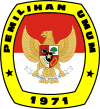1971 Indonesian legislative election
Legislative elections were held in Indonesia on 3 July 1971, the first under the New Order regime. There were ten participants; nine political parties and the "functional group" Golkar.
| |||||||||||||||||||||||||||||||||||||||||||||||||||||||||||||||||||||||||||||||||||||||||||||||||||||||||||||||
| Turnout | 96.6% | ||||||||||||||||||||||||||||||||||||||||||||||||||||||||||||||||||||||||||||||||||||||||||||||||||||||||||||||
|---|---|---|---|---|---|---|---|---|---|---|---|---|---|---|---|---|---|---|---|---|---|---|---|---|---|---|---|---|---|---|---|---|---|---|---|---|---|---|---|---|---|---|---|---|---|---|---|---|---|---|---|---|---|---|---|---|---|---|---|---|---|---|---|---|---|---|---|---|---|---|---|---|---|---|---|---|---|---|---|---|---|---|---|---|---|---|---|---|---|---|---|---|---|---|---|---|---|---|---|---|---|---|---|---|---|---|---|---|---|---|---|
| |||||||||||||||||||||||||||||||||||||||||||||||||||||||||||||||||||||||||||||||||||||||||||||||||||||||||||||||
 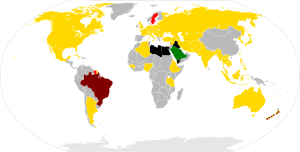 Top: Results of the local elections showing the party with the largest share of votes.
Bottom: Results of the overseas election showing the party with the largest share of votes. Golkar NU PNI Parmusi PSII Catholic Party | |||||||||||||||||||||||||||||||||||||||||||||||||||||||||||||||||||||||||||||||||||||||||||||||||||||||||||||||
Background
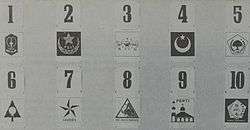
Following the Transition to the New Order from 1965–1967, the army-backed New Order regime announced that the Golkar organisation would be its political vehicle. The regime stressed that Golkar ("Functional Groups") was not a political party. In order to give General Ali Murtopo, a member of Suharto's personal staff, time to turn Golkar into an organisation fit to command a majority in the legislature, the general election originally planned for no later than 5 July 1968 was postponed to no later than 5 July 1971.[1]
After a time with no word from the government concerning the forthcoming election, on 22 October 1968, the Sinar Harapan daily reported a statement by President Suharto to the effect that the government had begun to take the necessary steps to organise the poll. A General Election Board was established in mid-1969 headed by Interior Minister Amirmachmud.[2] On 23 September 1970, the ballot paper numbers and electoral symbols for the 10 election participants were announced.[3]
A total of 6,000 tons of paper, 6 ships, 45,000 motor vehicles and 793,036 ballot boxes (lockable to ensure secrecy of the ballot) were needed for the election.[4]
Campaign
Themes and goals
Most of the main theme for campaign by the political parties were democracy and development. The Catholic Party promoted their "Three Programs", which included democracy, reform, and development. Their campaign head was I. J. Kasimo, who stated that the main goal for the Catholic Party was to protect human rights in Indonesia.[5] Similar to their Catholic counterpart, the Indonesian Christian Party also promoted human rights, also campaigning for regional autonomy, and the equal partnership of the army, Golkar, and political parties.[6]
Nationalist and socialist political parties, such as the Indonesian National Party (PNI) and Murba Party also emphasized the need to implement the Pancasila ideology and the Constitution of Indonesia. In a speech on national television, PNI leader Usep Ranawidjaja stated that Pancasila and constitution were the basic things that the government need to run the country and carry out the people's will. He also stated that democracy in the political system of Indonesia had to be performed with all of its consequences.[7]
Islamic political parties, such as Parmusi, Nahdlatul Ulama, and the Indonesian Islamic Union Party (PSII), also adopted a main campaign theme similar to other political parties. Parmusi, the newest party in the elections, stated on 17 March 1971, that the party would not establish an Islamic state or another new country, but the party would continue to defend Pancasila and the constitution. The party also stated that they supported the five-year plan of the government.[8] Nahdlatul Ulama stated at the front of national television on 29 April 1971 that one of their main goals for the election was to enforce and uphold the Sharia and the belief to God according to Pancasila. The party also supported the creation of villages as the basis of development, and industrialization as a way to abolish unemployment.[9] PSII campaign for the elections as a way to exemplify the democracy system in Indonesia. Even though PSII is an Islamic party, PSII emphasized their campaign on constitutional matters rather than religious matters.[10]
Unlike the other Islamic parties, Perti did not have any grandiose promises or ideals. Instead, Perti emphasized their campaign on rural matters, such as irrigation, roads, and agricultural matters. They insisted that problems in those sectors should be fixed immediately by the government. Perti itself viewed the elections as a way to educate the citizens to understand their rights and duties.[11]
Meanwhile, Golkar, which emerged as an organization rather than a political party in the election, stated their five-point political statement as their main basis for the campaign. The political statement stated that Golkar would implement out a system of democracy based on Pancasila, form a new and clean government, hold other elections, and secure the national revolution. Golkar further stated that "the new history of Indonesia was made possible by the cooperation of the army, people, and Golkar", and promised that Golkar would not be divided based on ideology, but rather would be a big tent.[12] The big tent principle of Golkar would later help it to be supported by large groups, mainly by the army and government employees.[13]
Conduct
Most of the campaign used traditional methods, such as mass gatherings and the display of banners. Mass gatherings mostly took place in stadiums, school fields,[14] and in multipurpose buildings.[15] Places of worship were also used by Islamic and Christian political parties to gather crowds. For example, the Catholic Party frequently gathered at the Jakarta Cathedral,[16] and the Islamic parties frequently used mosques as a way to rally their masses.[17]
A more modern tactic for campaign was also used by political parties, involving motor vehicles donated by the government. For example, the Nahdlatul Ulama party held a rally at Ujungpandang, involving around a thousand cars and motorcycles, and carrying around the symbol of Nahdlatul Ulama.[18] PSII was given several Toyota cars, along with several thousand rupiahs in cash for the maintenance. Cars were used by PSII for campaign purposes, and the party also built mosques.[19] Televisions and radio campaigns were also used widely by the political parties. This allowed politicians to make speeches, which then would be broadcast.[9]
Conduct
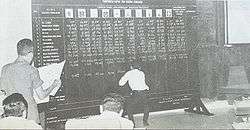
In order to weaken possible rivals to Golkar, the government manipulated the top two parties from the 1955 election, the Indonesian National Party PNI) and Parmusi (the successor to Masjumi following that party's banning in 1960) such that they lost credibility in the eyes of voters.[1] Given that the party that had come fourth, the Indonesian Communist Party, had been banned in the aftermath of the 30 September Movement coup attempt in 1965, that left only the Nahdatul Ulama (NU) as a major rival.[20]
Away from the political parties, civil servants were effectively obliged to vote Golkar and regional administrators were required to fulfill "quotas" of Golkar votes.[1]
The system of allocating seats was changed from that of the 1955 election to reduce the number of parties winning seats in the legislature. All seats were to be allocated in the regional electoral districts, rather than being divided up based on national results.[21]
The government also disqualified large numbers of candidates from the political parties. Hardest hit was the PNI, with 171 disqualifications leaving it with 506 candidates. Parsumi lost 141, and the NU lost 24 candidates.[22]
Results
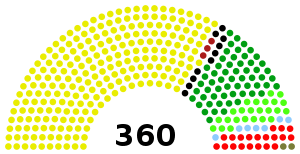 | ||||
|---|---|---|---|---|
| Party | Votes | % | Seats | |
| Golkar | 34,348,673 | 62.82 | 236 | |
| Nahdlatul Ulama | 10,213,650 | 18.68 | 58 | |
| Indonesian National Party | 3,793,266 | 6.93 | 20 | |
| Parmusi | 2,930,746 | 5.36 | 24 | |
| Indonesian Islamic Union Party | 1,308,237 | 2.39 | 10 | |
| Indonesian Christian Party | 733,359 | 1.34 | 7 | |
| Catholic Party | 603,740 | 1.10 | 3 | |
| Islamic Education Movement | 381,309 | 0.69 | 2 | |
| League of Supporters of Indonesian Independence | 338,403 | 0.61 | 0 | |
| Murba Party | 48,126 | 0.08 | 0 | |
| Total | 54,669,509 | 100 | 360 | |
| Registered voters/turnout | 58,179,245 | – | ||
| Source: Cribb & Kahin,[23] Nohlen et al.[24] | ||||
Notes
- Schwartz (1994) p32
- IKAPI (1972) p61
- IKAPI (1972) p77
- IKAPI (1972) p79
- Kompas, 29 April 1971
- Harian Kami, 1 May 1971
- Suluh Marhaen, 6 May 1971
- Pedoman, 3 May 1971
- Kompas, 1 May 1971
- Sinar Harapan, 3 June 1971
- Sinar Harapan, 26 May 1971
- Editorial of Suara Karya, 1 May 1971
- Suara Karya, 1 May 1971
- Duta Masyarakat, 7 May 1971
- Suluh Marhaen, 20 May 1971
- Harian Kami, 9 June 1971
- Harian Kami, 2 June 1971
- Duta Masyarakat, 1 May 1971
- Pedoman, 16 April 1971
- Ricklefs (1991)
- Central Election Commission (2000)
- May (1978) p249
- Cribb & Kahin, p494
- Dieter Nohlen, Florian Grotz & Christof Hartmann (2001) Elections in Asia: A data handbook, Volume II, p99 ISBN 978-0-19924-958-9
References
- Cribb, Robert; Kahin, Audrey (2004). Historical Dictionary of Indonesia. Scarecrow Press Inc. ISBN 978-0-8108-4935-8.
- IKAPI (Indonesian Student Press Association) (1972), Pemilihan Umum 1971 (1971 General Election) (in Indonesian), LPKP, Jakarta
- KPU (2000), Pemilu Indonesia dalam Angka dan Fakta: Tahun 1955-1999 (Indonesian Elections in Facts and Figures: 1955-1999 (in Indonesian), General Elections Commission (KPU)
- KPU (21 February 2008). "Pemilu 1971 (1971 Election)". KPU website. General Elections Commission (KPU). Retrieved 20 December 2018.
- Liddle, R. William (1994), Pemilu Indonesia dalam Angka dan Fakta: Tahun 1955-1999 (Indonesian Elections in Facts and Figures: 1955-1999 (in Indonesian), LP3ES, Jakarta, ISBN 979-8015-88-6
- May, Brian (1978), The Indonesian Tragedy, Routledge & Kegan Paul, ISBN 0-7100-8834-5
- Ricklefs, M.C. (2008) [1981], A History of Modern Indonesia Since c. 1200 (4th ed.), Palgrave MacMillan, ISBN 978-0-230-54686-8
- Schwarz, Adam (1999), A Nation in Waiting: Indonesia in the 1990s (2nd ed.), Allen & Unwin, ISBN 9781760636913
- Sekretariat Negara Republik Indonesia (1975), 30 Tahun Indonesia Merdeka: Jilid 3 (1965-1973) (30 Years of Indonesian Independence: Volume 3 (1965-1973) (in Indonesian), Sekretariat Negara Republik Indonesia

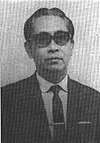
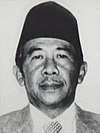
%2C_p336.jpg)
_di_Republik_Indonesia%2C_p346.jpg)


